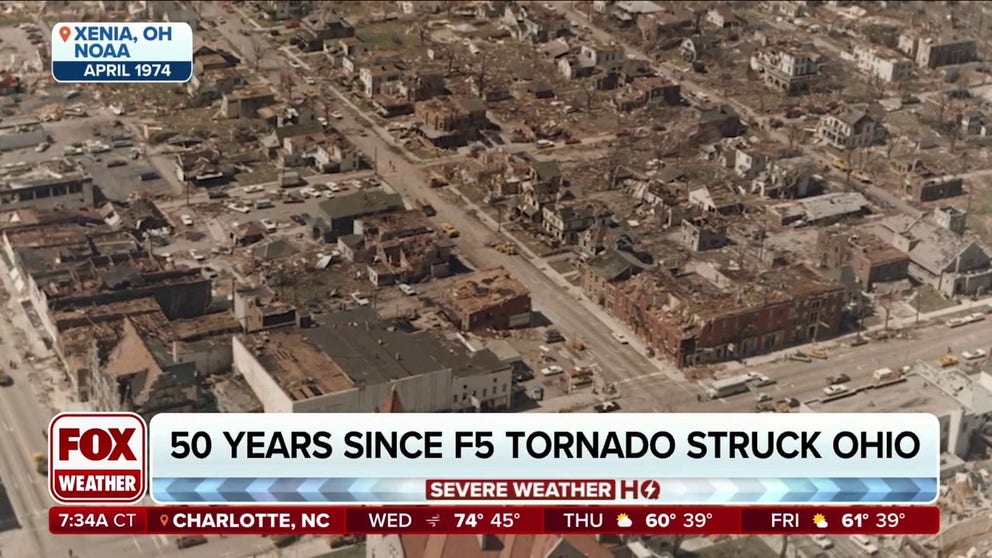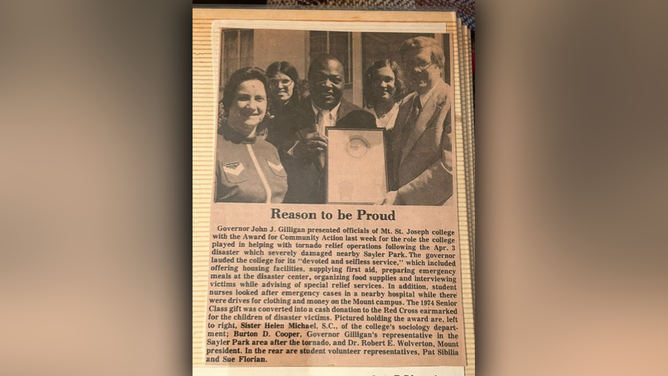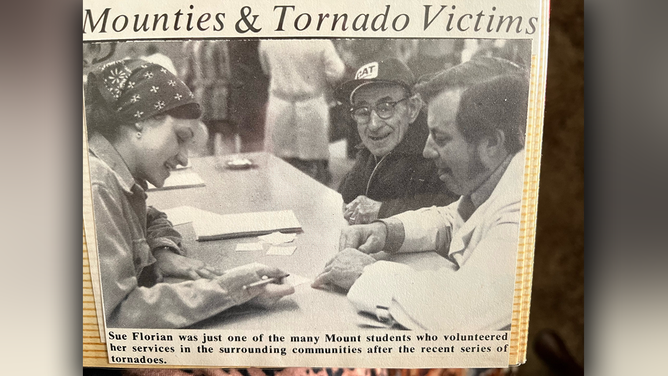'Worst tornado outbreak in US history': A look back 50 years after Super Tornado Outbreak of April 3-4, 1974
FOX Weather takes a look back at the 50th anniversary of one of the deadliest tornado outbreaks in American history that killed 335 people. According to NOAA, the outbreak changed the way the NWS forecasts storms and warns the public about dangerous events.
Ohio tornado survivor recalls 1974 severe weather outbreak
Tornado survivor Sue Garofalo describes the severe weather outbreak of 1974 in Xenia, Ohio.
Fifty years after the Super Tornado Outbreak of April 3-4, 1974 left trails of destruction across a wide swath of the eastern US, the twisters are still vivid in survivors' minds. It is still known as the "worst tornado outbreak in United States history," according to the NWS.
In just 16 hours, at least 148 tornadoes ravaged 13 states from the Great Lakes to the Gulf of Mexico. The event holds the record for the greatest number of F5 tornadoes in a single day. The violent twisters killed 335 people and injured more than 6,000. More than 27,000 families suffered loss. President Richard Nixon declared 10 states disaster zones.
"In terms of number of tornadoes, length of tracks, total area affected and damage, the April 3-4, 1974 tornado outbreak was the greatest in recorded history," read NOAA's Natural Disaster Survey Report 74-1 about the outbreak. "Several of the 127 tornadoes documented at this writing were among the most severe ever observed."
HOW LONG DO TORNADOES LAST AND HOW DO THEY FORM?
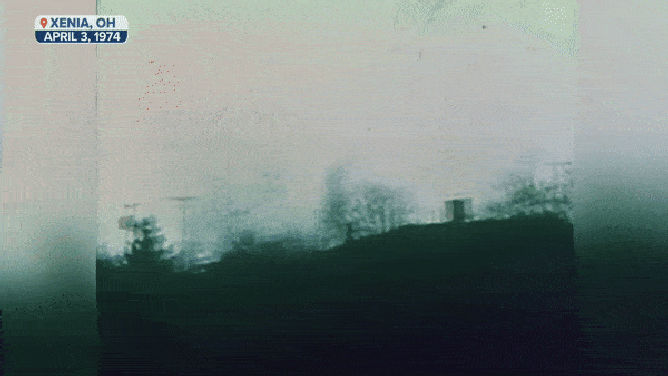
The F5 tornado plowing through Xenia, Ohio.
(FOX Weather)
Still horrible memories 50 years later
Sue Garofalo was just 18 years old at the time but still remembers the terror vividly. She said even today, when tornadoes strike, she thinks about April 3, 1974. The outbreak still haunts her dreams too.
HOW DOES A TORNADO OUTBREAK HAPPEN?
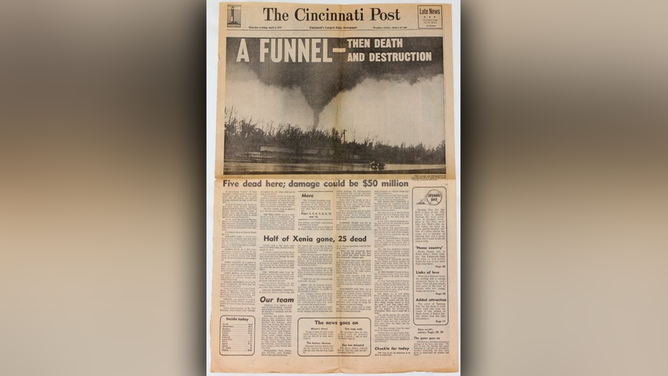
The front page of the Cincinnati Post after the tornado outbreak.
(Cincinnati Post and Sue Garafalo / FOX Weather)
Fifty years ago, she had no warning of the F5 tornado bearing down on Xenia, Ohio - just one of the killer tornadoes in the outbreak.
"So we had no clue. It was a day I was visiting a family with 10 kids waiting to have dinner. We were just going on with life as normal," Garofalo told FOX Weather. "We had transistor radios in those days and television. But of course, the TV wasn't on with 10 kids in the house."
HERE'S WHERE TORNADOES ARE MOST LIKELY TO OCCUR IN EACH MONTH
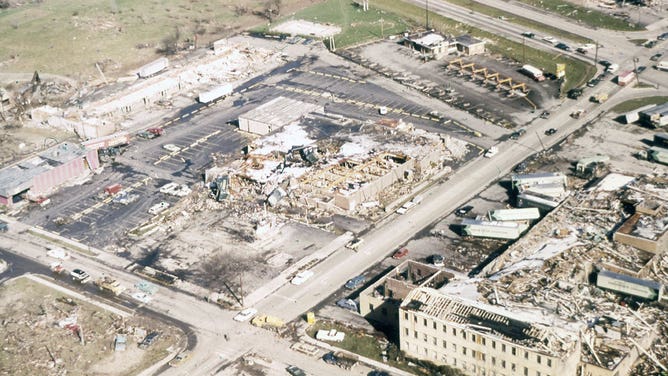
Aerial view of the devastation left behind after an F-5 tornado tore through Xenia, Ohio, April 3, 1974. Image courtesy U.S. Department of Defense.
(Smith Collection/Gado / Getty Images)
She remembers it raining, then the sky turned yellow. It got dark, and the wind picked up suddenly.
"We basically witnessed the event by pure chance when the sky started to turn a very weird color. It was very humid and hot, and we looked up, and it was just a strange yellow-y glow to the sky," she continued. "And once we went back inside, hail started and it was breaking the windows in the house. And that's when we actually knew something was going on."
She ran upstairs to get her friend before taking cover. The door blew open.
WHY DOES THE SKY SOMETIMES TURN GREEN DURING THUNDERSTORMS?
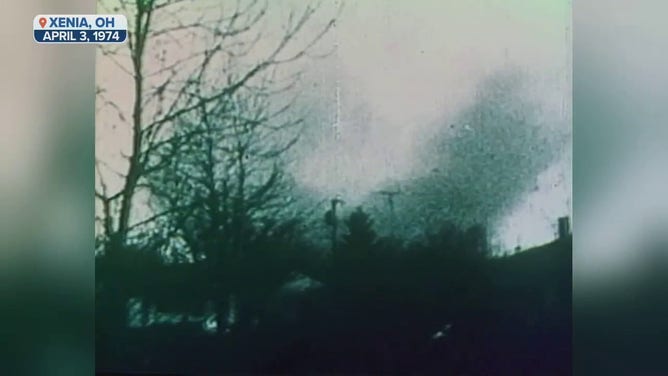
The tornado over Xenia, Ohio.
(FOX Weather)
"The most vivid moment, of course, was actually seeing a funnel cloud. And it's something you always think about," Garofalo said. "At 18 you take for granted, ‘this is never going to happen to me’, but after the windows were breaking, I looked out the front door and I could actually see a funnel cloud."
She and the other kids huddled under a ping-pong table in the basement.
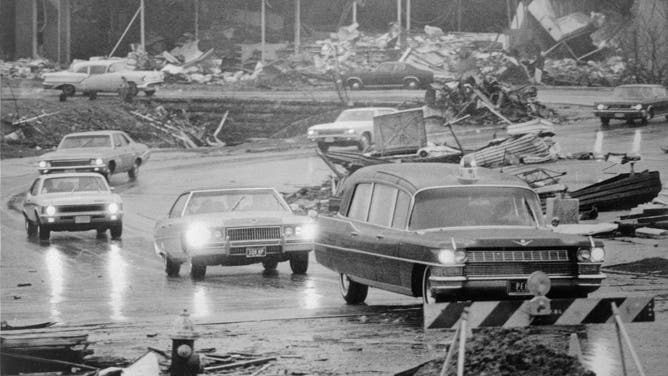
File: A funeral procession bearing one of the victims of last weeks devastating tornado passes through the streets in Xenia.
(Bettmann / Getty Images)
"By the time we got down there, I looked out the back window and I could see it was probably on the ground, just somewhere behind it (the house), because it came down into a ‘V’ of blackness," she recalled. "Everything was light outside, and I could see big trees, like huge trees bouncing through the backyard like toothpicks, and you could hear the debris hitting the house."
Everyone in the house escaped without injury, but 41 people died across Ohio. She said Xenia looked like a war zone. Garofalo, then known as Sue Florian, received an award from the governor for her volunteer work to help survivors.
WHERE ARE TORNADOES MOST COMMON?
At three years old, Garofalo's daughter Meredith heard her mother tell the horrific story and became passionate about weather. Meredith is now a meteorologist in Cleveland.
"So I think God was working through me for a better cause, to save lives," Sue Garofalo said.
TORNADO SAFETY: HOW TO IDENTIFY THE SAFEST PLACES INSIDE YOUR HOME
Tornadoes tore across 13 states
The 1974 outbreak started with the first tornado at 9:30 a.m. in Indiana on April 3, peaked between 2 p.m. and 10 p.m. and it wasn't until 8 a.m. on April 4 when the last tornado touched down in North Carolina, according to NOAA. The agency estimated $600 million in damages, or about $5.3 billion in today's dollars.
"It was actually a severe thunderstorm complex that developed, and I studied in college, it was so epic," remembers FOX Weather Meteorologist Bob Van Dillen. "And you see some of the footage coming in from Xenia, Ohio. It was the F5 tornado destroyed most of the town. We studied it in Millersville for our synoptic (meteorology) class. And because it was just a perfect storm, 148 tornadoes in a two-day span from the deep South all the way up through the Ohio Valley."
The outbreak ranks as the second-largest tornado outbreak in the nation by the numbers. Only the Super Outbreak of April 27, 2011 spawned more tornadoes in a single calendar day with 209. April 1974 also went down in history books as the highest number of tornadoes in a given month with 760, according to Arizona State University.
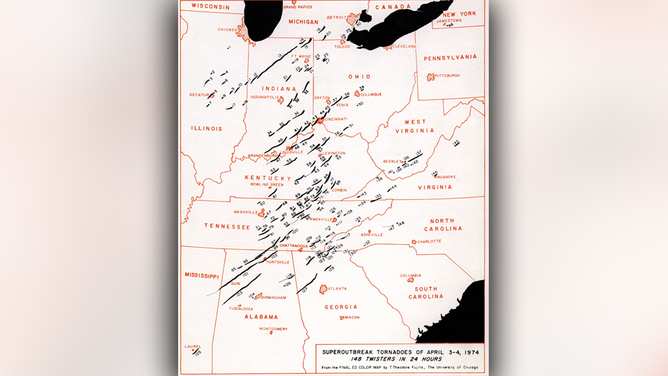
Each line represents a tornado during the outbreak.
(T. Theodore Fujita, The University of Chicago / NOAA)
"Many of the tornadoes moved at speeds exceeding 50 mph, and two in particular followed identical paths, causing more than half of the recorded deaths from the outbreak and striking many communities twice in under an hour," wrote NOAA.
NWS meteorologists issued a total of 30 Severe Weather Watches, about 150 Tornado Warnings and 100 Severe Thunderstorm Warnings over the two days.
Initial survey results showed a total of 127 tornadoes traveled a total of 2,014 miles. About 118 tornadoes traveled at least one mile. The mean path length for the outbreak was 18.7 miles. That's an unimaginable number compared to the average path length for all tornadoes from 1973 of 4.7 miles. And NOAA had already dubbed 1973 "the year of the tornado" because of the number and strength of the storms.
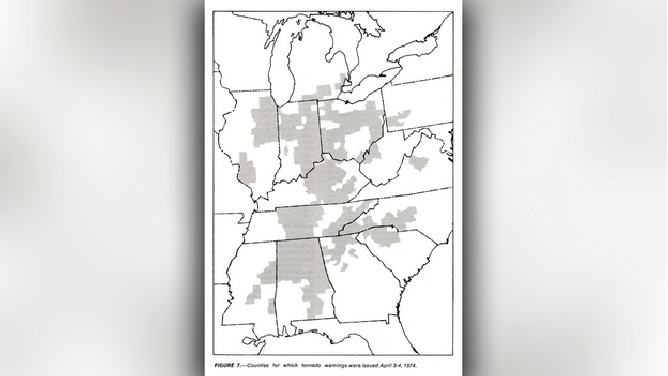
The area covered by Severe Storm and Tornado Watches in hatched and the area covered in Tornado Warnings in solid gray for April 3-4, 1974.
(NOAA)
The super outbreak changed the NWS
The super outbreak changed the way both the NWS and TV broadcasters delivered warnings, according to NOAA.
"The magnitude of this outbreak tested NOAA's tornado warning system fully," the NOAA disaster survey report read. "The survey … revealed the need to assess the effectiveness of the nation's warning system and to find ways to improve the system further."
After the outbreak, municipalities activated the Emergency Broadcast System more frequently. TV anchors began extending coverage beyond normal operating hours for the station. NOAA Weather Radio expanded.
WHAT TO PUT IN AN EMERGENCY KIT

File: The county courthouse here, and a row of business buildings, (left) had the roofs ripped off them after a tornado swept down and tore through Jasper, Alabama's main street, destroying or damaging virtually every building in the downtown district.
(Bettmann / Getty Images)
"This nation’s response to this devastating event paved the way to significant improvements in observation technology, including the development of Doppler Radar and GOES satellites," stated NOAA. "Furthermore, it brought to light the need for a massive reorganization of the National Weather Service."
The service employed the Modernization and Associated Restructuring program which accelerated the agency's ability to forecast dangerous storms faster and broadcast warnings "in a more timely manner," said NOAA.
